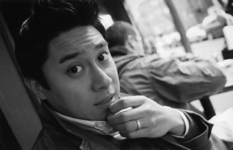
R.A. Villanueva lives in Brooklyn. Recent writing has appeared or is forthcoming in journals such as Indiana Review, Virginia Quarterly Review, AGNI, McSweeney’s Internet Tendency, DIAGRAM, The Literary Review, and The Collagist. A Kundiman fellow, he is currently a Language Lecturer at New York University.
In our Process Profiles series, young contemporary Asian American poets discuss their craft, focusing on their process for a single poem from inception to publication. Here, R.A. Villanueva discusses his poem “In Memory of Xiong Huang,” which first appeared in the Winter 2009 Issue of Virginia Quarterly Review.
* * *
Ars Poetica with Illuminated Bodies
1.
At the heart of Michael Paterniti’s “The Most Dangerous Beauty” is a description of the Topographische Anatomie des Menschen that is, by turns, lyrical and grotesque. Truth be told, Paterniti’s cluster of renderings and pivots is less a “description” of Eduard Pernkopf’s life work and more a walking tour of his Anschluss abbatoir-made-studio.
Paterniti offers an unfurling litany, a conjuring of Pernkopf’s Anatomy that reckons with how “page by page” these medical illustrations grow increasingly “stunning, bombastic, surreal.” He affirms that it is “bone-and-muscle evidence, the animal reality of who we are beneath the skin” before doubling-back: “what if a number of these paintings have been signed with swastikas, what then?…Do the secrets revealed in the Book count less than the secrets kept by it?”
What starts as an unveiling of an atlas of the body thus becomes for us a visceral interrogation of how we reconcile our ethics with our want to see, our need to know. By essay’s close, beauty is everywhere cut with casualty and grief.
2.
Without much thought, I suggested that my cousins and I make the last stop on their sightseeing trip South Street Seaport. We could walk the perimeter of the island, come around on the Battery, and up the East Side, take photos of the museum ships and their moorings, the Brooklyn waterfront, Olafur Eliasson’s “Waterfalls” from the esplanade. That way you have things both permanent and temporary, I said.
That summer, it felt as though every double-decker bus, every subway banner, and every taxi ad in the city promised tourists cadavers split down the middle, a carnival of Mercurochrome-stained biceps and hearts that would teach us how our insides worked. You couldn’t evade the signs—couldn’t outrun them if you tried—and so none of us was surprised when we found ourselves following the towpaths’ posters and arrows into the dark of an exhibition space.
Here is what I remember most about that afternoon: a couple at the coat check knotting together shopping bags, changing batteries in their camera; the words “limited engagement only” in white, sans-serif; latticework of veins in solution, contour of a torso preserved as a system of vessels and pipettes; lit from below, wombs glossed and translucent, lungs flayed and lacquered; that the docent’s measured answer was “from donations, mostly;” how even though the bodies before us posed without names or stories, I knew from just their eyes and lips where they came from.
3.
I started what was initially called “These nameless muscles” that same fall, for a craft seminar at NYU led by Kimiko Hahn. Our focus was the reinvigoration of inherited forms (the sestina, the sonnet, the villanelle, et al.) and the fourth exercise of the term called on us to write an elegy that could test the permeable line between lament and praise song.
The first draft of my response was a little more than a list, really—a catalogue of images recorded during that disconcerting visit to the Seaport. The title of that early version announces as much and what follows that phrase is an insistent sequence of colors, dissections, and apprehensions loosely reassembled. I had wanted to vivify and reclaim a cadaver’s forgotten life and instead I was writing about myself.
I tried to leave the assignment. I searched for “bodies” and “New York City,” “testimony” and “protest.” I read investigative profiles and apologia. I found interviews with anatomist Dr. Gunther von Hagens wherein he defends his exhibit’s “educational aims” and the patent art of Animal and vegetal tissues permanently preserved by synthetic resin impregnation. I listened to his spokesman rationalize “human specimens” for study harvested through “normal processes.”
Echo soon delivered echo. Von Hagen’s mechanism for “plastination” became bound with language like “unclaimed” and “unidentified,” alternative splicings which brought to light Wanqing Huang and his younger brother’s act of selflessness:
…as a boy Xiong once went grocery shopping with his grandmother. On the walk home, Xiong complained so strongly about how hard his grandmother had bargained with the peasant for their vegetables that she was forced to return with little Xiong and pay more.
It is this gentle, sorrowed invocation which gives pulse to the poem.
In Memory of Xiong Huang
who disappeared from Shanghai and whose body, his brother believes,
is now on display in New York City in an exhibition of plastinated cadaversIn some province a hemisphere from here
you tapped at your grandmother’s kneecap, her elbow
crooked in bags of bok choy, bamboo shoots,
and rapeseed oils. You shouldered her skins
of bean curd all the way back to market,
offered coins from your pocket up
towards a farmhand she paltered for bargains.Of you and that day, your brother remembers this most:
how your diaphragm shook as if sorry
for the quick of her tongue. How each capillary
and joint grieved the reach of her teeth. And he swearshe sees your red wince in the subway ads,
this bus stop poster where you have become a mannequin
of tendons, a mock Thinker pumped with tinctures
and phosphorescent balms, cured,desiccated in silicon gas. Your flayed fist
against a mandible, your brother lays hands
on your knuckles. He traces aloud
the syllables of your given name. Imagines
the sound of a boy’s now ossified heart.
Oh R.A.! How his work makes me sigh! If only he were a woman who liked women! Sigh!